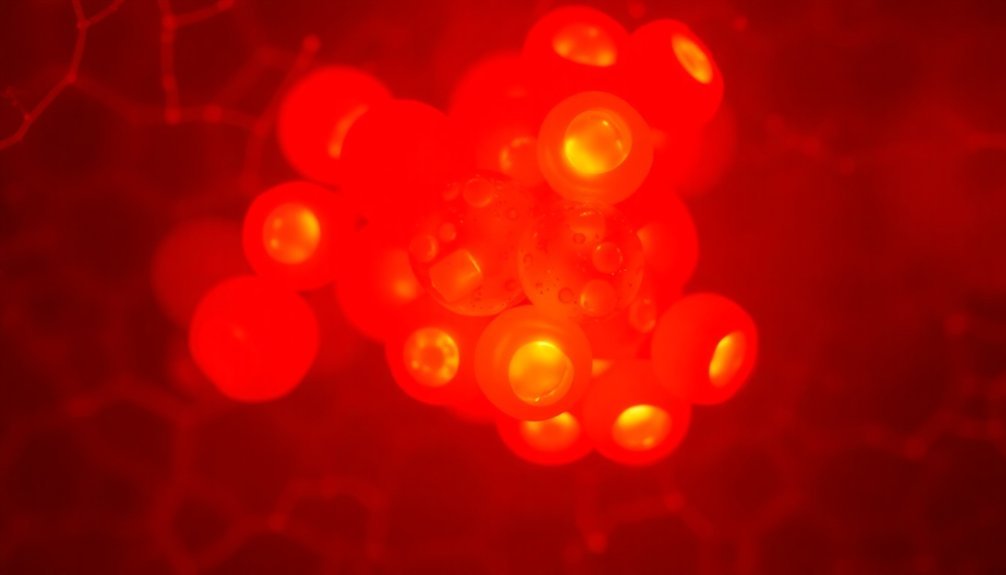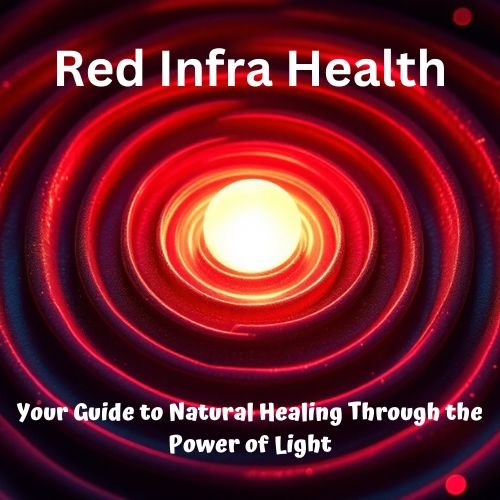Red light therapy naturally boosts your testosterone levels through three powerful mechanisms. First, it stimulates Leydig cell regeneration in your testes, enhancing their ability to produce testosterone. Second, it activates your mitochondria's energy production, improving cellular function and hormone synthesis through increased ATP and better blood flow. Third, it optimizes your pineal gland, which helps regulate hormone production and maintain healthy circadian rhythms. When these three systems work together, you'll experience improved testosterone levels, better energy, and enhanced overall hormonal balance. Discover how these mechanisms can transform your hormone health with targeted red light exposure.
Leydig Cell Regeneration

In response to aging and environmental factors, Leydig cells undergo complex regenerative processes that begin with specialized vascular cells in the testes. These cells, which originate from vascular smooth muscle cells and pericytes, express nestin – a protein marker typically found in nervous system stem cells. The transformation process involves acquiring steroidogenic properties while gradually losing their original vascular characteristics.
When your body needs to produce new Leydig cells, these progenitor cells start to multiply and transform. During this transformation, you'll find that the cells lose their smooth muscle characteristics and develop the ability to produce testosterone. This process is marked by rapid changes in nestin expression as the cells mature into functional Leydig cells.
These newly formed cells respond to luteinizing hormone (LH) and begin testosterone production.
If you're experiencing age-related testosterone decline, it's important to understand that it's not due to Leydig cell loss but rather decreased functionality. Several factors affect their performance, including oxidative stress and increased COX-2 levels, which can suppress testosterone production.
Your body's ability to regenerate these cells offers hope for maintaining hormone levels, as properly functioning Leydig cells are essential for testosterone production and overall male health.
Mitochondrial Energy Production
Mitochondrial energy production forms the cornerstone of cellular health and hormone synthesis in your body. When you expose your cells to red light therapy, you're activating cytochrome c oxidase, which enhances ATP production and improves the efficiency of your electron transport chain. This boost in cellular energy directly supports testosterone production and overall hormonal balance.
Red light therapy's ability to dislodge nitric oxide from key sites in your energy production chain creates a dual benefit: it enhances ATP generation while improving blood flow through vasodilation. You'll experience enhanced nutrient delivery to hormone-producing cells, particularly the Leydig cells responsible for testosterone production. Incorporating resistance training into your routine further amplifies these benefits by increasing mitochondrial biogenesis and function.
The therapy triggers mitochondrial biogenesis, meaning your cells create new mitochondria. This increased mitochondrial density translates to greater energy output and improved hormone synthesis.
You'll also benefit from reduced oxidative stress and inflammation, as red light therapy promotes the production of beneficial ROS that support healing processes. When combined with resistance training and proper nutrition, you're creating ideal conditions for both mitochondrial function and testosterone production, helping maintain robust hormone levels even as you age.
Pineal Gland Optimization

Light's profound effects on your pineal gland make red light therapy a powerful tool for enhancing this essential endocrine organ. Your pineal gland serves as your body's internal timekeeper, regulating sleep cycles and hormone production through melatonin secretion.
When this gland functions effectively, it helps maintain stable mood, energy levels, and immune system performance. Calcium deposits can impair proper pineal gland function over time.
Red light therapy can enhance your pineal gland's performance by stimulating melatonin production and helping regulate your circadian rhythm. This non-invasive treatment supports your body's natural sleep-wake cycles, which directly impacts testosterone and other hormone levels.
As you age, your pineal gland naturally produces less melatonin, but red light therapy can help counteract this decline.
The therapy's ability to influence your pineal gland extends beyond sleep regulation. It helps maintain hormone balance by supporting the gland's influence on your pituitary function, which controls vital male hormones like FSH and LH.
Frequently Asked Questions
Can Red Light Therapy Help With Erectile Dysfunction?
Yes, you'll find red light therapy can help with erectile dysfunction by improving blood circulation, boosting testosterone production, and reducing inflammation. It's a natural treatment that promotes better sexual function without harmful side effects.
How Long Until Testosterone Levels Increase After Starting Treatment?
You'll likely notice initial testosterone increases within 4 days of starting red light therapy. More significant changes develop over 6 weeks, with substantial physical improvements showing up between 3-6 months of consistent treatment.
Is Wearing Protective Eyewear Necessary During Red Light Therapy Sessions?
Yes, you'll absolutely need protective eyewear during red light therapy sessions. Without proper eye protection, you're risking serious damage to your retina. Never skip wearing specialized goggles or masks designed for this treatment.
Does Red Light Therapy Work Better Before or After Exercise?
You'll get different benefits either way. Use red light therapy before workouts to boost performance and energy, or after exercise to speed up recovery and reduce muscle soreness. Both timing options are effective.
Can Medications Interfere With the Effectiveness of Red Light Therapy?
While there's no strong evidence that medications interfere with red light therapy's effectiveness, you should consult your healthcare provider, as some drugs affecting mitochondrial function or ATP production could theoretically impact results.
In Summary
You've now discovered three powerful ways red light therapy can boost your testosterone levels: stimulating Leydig cell regeneration, enhancing mitochondrial function, and optimizing your pineal gland. By incorporating regular red light sessions into your routine, you're taking a natural approach to hormone optimization. Whether you're looking to build muscle, increase energy, or improve overall vigor, red light therapy's hormonal benefits can help you achieve your goals.





Leave a Reply